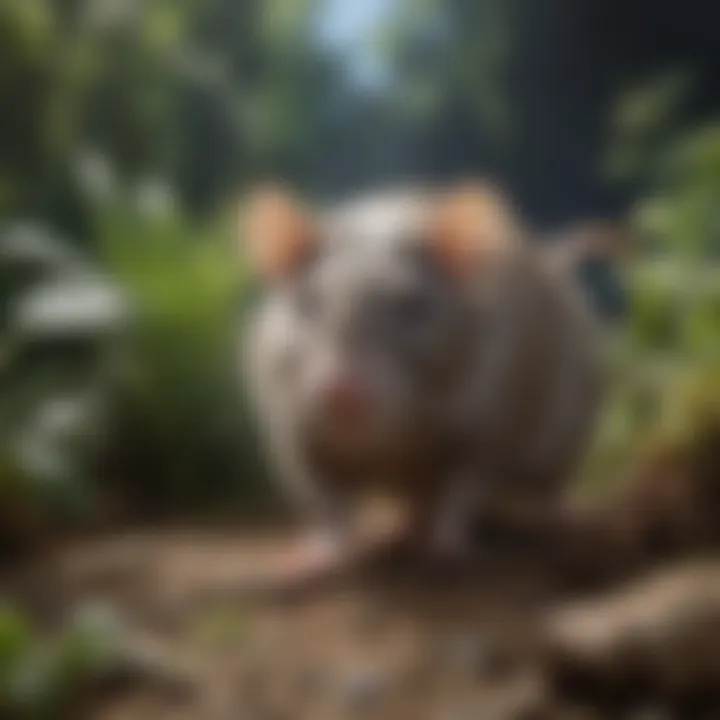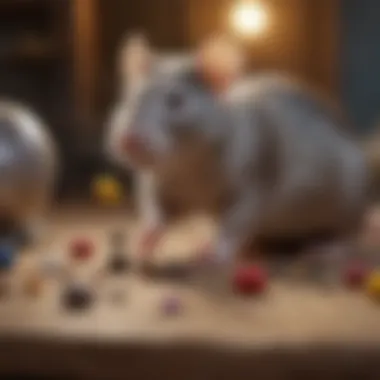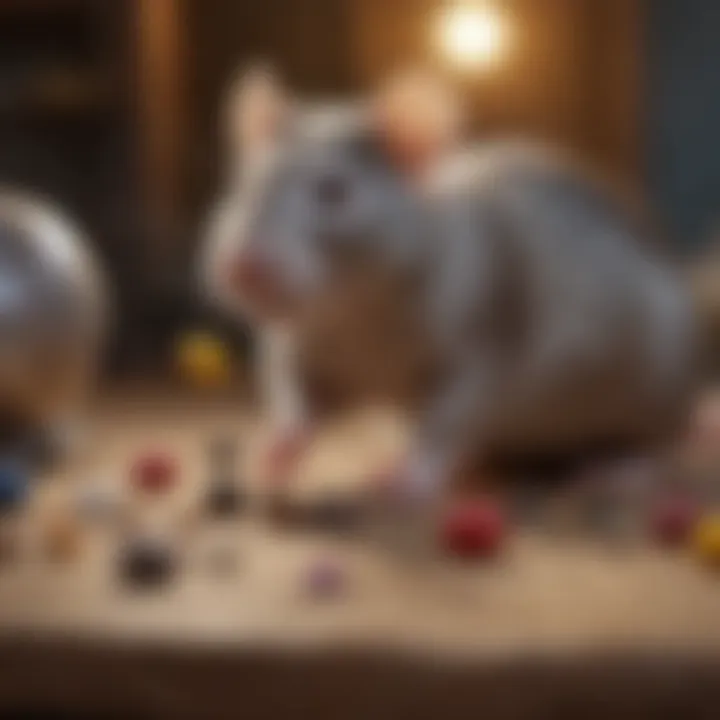Optimal Rat Habitats: Essential Living Conditions


Intro
When considering pet ownership, particularly with species like rats, it is essential to understand their specific habitat needs. Rats, often misunderstood, have distinct preferences that influence their well-being. This exploration digs into how to create ideal living conditions for your pets, ensuring both comfort and security. Knowledge about rat behavior, care requirements, and the importance of enrichment will help owners make informed decisions.
Understanding Your Pet
Pet Behavior Basics
Rats exhibit a range of behaviors that reflect their intelligence and emotional depth. They are social animals that thrive in groups, often forming strong bonds with their companions. Understanding their body language is crucial. For instance, a relaxed rat may display a calm posture, while an agitated rat may exhibit rapid tail movements. Observing these behaviors can enhance your interaction and improve their living conditions.
Common Breed Characteristics
Different breeds of rats, such as the Dumbo or the Hooded, possess unique traits. Dumbo rats, known for their large, floppy ears, tend to be more docile and friendly. Hooded rats have clear markings, often exhibiting curious and active behaviors. Each breed brings its own characteristics that can affect their environment needs, ensuring that owners tailor habitats accordingly.
Species-Specific Needs
Identifying what a rat needs is fundamental. They prefer environments that mimic their natural habitat, which includes plenty of space to explore and hide. Optimal temperature ranges should be maintained, typically between 65°F to 75°F. Additionally, providing appropriate bedding materials, such as aspen shavings or paper bedding, contributes significantly to their comfort.
Pet Care and Maintenance
Feeding Guidelines
A balanced diet is vital for your pet rat's well-being. They require a mix of high-quality pellets, fresh fruits, and vegetables. Avoid processed foods high in sugar or fat. It is essential to monitor their diet to prevent obesity-related health issues, which are common in domesticated rats.
Grooming Essentials
While rats are generally tidy creatures, occasional grooming is necessary. Regularly check their coats for any signs of matting or debris. Using a soft brush can help maintain cleanliness and promote bonding.
Hygiene Practices
Cleanliness is crucial for a rat’s health. Their habitat should be cleaned at least once a week to prevent odor and bacteria build-up. Remove any soiled bedding and replace it with fresh materials. Thoroughly clean the food and water containers daily.
Training and Development
Basic Commands and Skills
Rats can be trained to perform simple tasks and commands. Teaching them to come when called or to navigate through mazes can foster a stimulating environment. Use positive reinforcement techniques, like treats, to encourage learning.
Behavioral Training Techniques
Behavioral issues may arise, such as nipping or excessive chewing. Identifying triggers is important. Redirecting behavior through play or providing appropriate chew toys can alleviate them.
Addressing Common Behavior Issues
Common behavioral issues may include aggression or anxiety. Ensuring a stable environment with minimal disturbances is crucial. Giving them safe spaces to retreat can help minimize stress.
Health and Wellness
Routine Vet Check-ups
Routine veterinary check-ups are necessary to identify and address health concerns early. A professional can provide vaccinations and advice on overall care.
Vaccination Needs
Understanding which vaccinations are essential for your pet rat is important. These often include vaccines for conditions such as leptospirosis and mycoplasma pneumonia. Consult your veterinarian to stay informed.
Recognizing Signs of Illness
Pet owners should remain vigilant about signs of illness in their rats. Symptoms can include lethargy, changes in eating habits, or unusual vocalizations. Prompt attention can prevent serious health issues from developing.
Enrichment and Activities
Indoor vs.
Outdoor Activities
While indoor activities are essential for safety, rats enjoy supervised outdoor time in a secure area. Indoors, provide tunnels and climbing structures to encourage exploration. Outdoor settings can promote additional physical activity if monitored closely.
Interactive Toys and Games
Rats thrive on mental stimulation. Providing interactive toys, like foraging puzzles or chew toys, can significantly enhance their well-being. Changing toys periodically keeps their environment interesting.
Socialization Opportunities
Socialization is vital for a rat's happiness. Interaction with other rats, as well as regular human engagement, supports their emotional health. Consider adopting pairs or groups to satisfy their social needs.
Understanding and meeting the habitat requirements of your pet rat is essential for their overall health and happiness. The right environment, coupled with proper care, can lead to a rewarding pet ownership experience.
Prelude to Rat Habitats
Understanding the habitats in which rats thrive is essential for any pet owner or animal lover. This section introduces the fundamental aspects of rat habitats while highlighting the critical components that affect their well-being and day-to-day life. By grasping the significance of habitat design, readers can create spaces that accommodate both the physical and behavioral needs of rats.


The benefits of a well-designed habitat extend beyond mere aesthetics. A suitable environment fosters comfort, reduces stress, and enhances overall health among pet rats. This is particularly important because rats are social creatures, and their environment should reflect their natural tendencies.
Understanding Rat Behavior and Needs
Rats exhibit unique behaviors and needs that must be considered when creating their living spaces. They are active, curious animals that require stimulation and room to explore. Space to move, climb, and burrow is vital for their mental health. Furthermore, understanding their social nature is crucial. They thrive in the company of other rats and benefit from interactive play and social bonding.
Additionally, understanding their natural instincts can aid in habitat design. For instance, rats enjoy hiding and creating nests. A habitat that provides shelters and various hiding spots can significantly reduce anxiety and encourage natural behaviors.
Natural vs.
Domestic Habitats
The differences between natural and domestic habitats for rats are significant. In the wild, rats inhabit diverse environments, often consisting of tunnels, vegetation, and warmth. They adapt quickly to their surroundings and utilize their environmental features effectively.
Conversely, domestic habitats are often limited in size and complexity. While they provide safety and protection from predators, it is essential to incorporate elements that mimic their natural habitats. By including tunnels, platforms, and textured surfaces, owners can create enriched environments that support the mental and physical well-being of their rats. This combination of understanding their natural behavior and adapting it to a domestic setting can lead to healthier, happier pets.
Types of Rat Habitats
Understanding the different types of rat habitats is essential for providing optimal living conditions. Each habitat type comes with specific features and benefits that can significantly affect the well-being of pet rats. Cages, homes, terrariums, and outdoor spaces each offer unique considerations that cater to a rat's natural instincts, behavioral needs, and social dynamics. Knowing what is available helps pet owners make informed decisions in creating a comfortable environment for their furry friends.
Cages: Key Features
Cages are a primary habitat choice for most pet rats. Several key features contribute to an effective cage setup. First, the size of the cage is crucial. Rats require ample space to explore, exercise, and establish territories. A minimum of two cubic feet per rat is recommended, but larger spaces can enhance their quality of life.
Another important aspect is the bar spacing. Spacing should be narrow enough to prevent escapes, typically no larger than half an inch. This ensures that even small or juvenile rats cannot slip through. Furthermore, a multi-level cage design allows rats to climb and play, catering to their natural tendencies.
Adequate ventilation is also essential. Rat cages need airflow to mitigate ammonia buildup from waste, keeping the environment healthy. Additionally, easy-access features such as removable trays for waste collection and cleaning facilitate regular maintenance, which is vital for overall habitat hygiene.
Homes and Terrariums
Homes and terrariums serve as alternative habitats that mimic rats’ natural environments more closely. Wooden homes, for example, provide a cozy and warm place for rats to nest. These habitats often incorporate various materials like cardboard, paper, and fabrics to create comfortable nesting options. The choice of materials needs to be safe and non-toxic, ensuring the health of the pets.
Terrariums, on the other hand, offer a visually appealing and secure setting for rats. They allow for better visibility, making interactions enjoyable for both the rats and their owners. A terrarium setup requires careful selection of substrates, ensuring a safe and clean environment. Additionally, enriching elements like tubes, corners for burrowing, and hideaways can stimulate a rat’s curiosity and provide safe spaces for rest and play.
Outdoor Habitats
Outdoor habitats can be a fantastic addition, provided they are safe and secure. These environments can offer fresh air and natural stimulation, which can be quite beneficial for rats. However, precautions are necessary to prevent any potential hazards, such as predators or harsh weather conditions.
For outdoor setups, a secure, escape-proof enclosure is essential. Materials should be sturdy, avoiding any structures that permit burrowing or climbing out. Providing shade is important to prevent overheating under direct sunlight. Additionally, access to a clean water source should always be available. Integrating natural elements like grass patches or wooden structures can enhance the outdoor experience, allowing rats to engage in natural behaviors, thus improving their overall well-being.
Consider how each habitat type supports rat behavior and needs. Balancing safety, comfort, and stimulation is key to a healthy and happy rat.
By understanding the characteristics of various rat habitats, pet owners are better equipped to create environments that satisfy their pets' natural instincts and requirements.
Essential Elements of a Rat Habitat
Creating an appropriate habitat for rats is crucial for their health and happiness. A well-designed habitat can significantly enhance their quality of life. Elements such as space, shelter, and bedding play a vital role in ensuring that rats thrive in captivity. Understanding these components helps pet owners meet their furry friends' needs better and fosters a comfortable living environment.
Space Requirements
Rats are naturally active animals. Therefore, adequate space is essential in any habitat. They require room to explore, play, and exercise. A cramped environment can lead to stress and aggression among rats, affecting their overall well-being.
When selecting a cage or habitat, consider the following:
- The size of the cage should be proportionate to the number of rats. For a pair of rats, a cage with a minimum space of 24 inches high, 24 inches wide, and 12 inches deep is advisable.
- Multilevel cages can also be beneficial, providing vertical space for climbing and exploration.
- Ensure that the layout allows for different zones where rats can engage in various activities, like eating, sleeping, and playing.
Shelter and Nooks
Shelter is another essential element in a rat's habitat. Rats need safe places to hide and rest. This help them feel secure and reduces their stress during daylight hours when they are less active.
- Create nooks or hideouts using materials like wood, cardboard, or ceramic pots. Rats enjoy burrowing and often feel more relaxed in enclosed spaces.
- Provide access to multiple shelters so that the rats can choose their preferred spots. This allows for social dynamics if you house multiple rats together.
- Ensure that the shelters are easy to clean and maintain to avoid hygiene issues.
Bedding and Substrates
The choice of bedding is vital for a rat’s comfort and health. Bedding should provide warmth, absorb moisture, and allow for digging and burrowing.
- Avoid cedar or pine shavings, as these can be harmful to rats. Instead, opt for paper-based bedding or aspen shavings.
- The bedding should be deep enough to allow rats to dig and create nests, which is a natural instinct.
- Regular maintenance is essential. Clean the bedding frequently to prevent odors and promote a healthy environment.
Proper bedding and shelter not only enhance comfort but also promote good hygiene and enrich the life of pet rats.
By prioritizing these essential elements, pet owners can create habitats that support the physical and mental needs of their rats. Understanding the requirements will lead to better pet care and happier rats.
Ventilation and Temperature Control
Maintaining an appropriate environment for rats involves careful attention to ventilation and temperature. These factors significantly impact their overall health and well-being. Proper airflow ensures that the living space remains comfortable, reducing the risk of respiratory issues that can arise from poor air quality. Likewise, sustaining ideal temperature ranges is vital in preventing stress or discomfort among these animals.
Importance of Airflow
Airflow plays a crucial role in rat habitats. It helps to disperse any accumulated odors and airborne contaminants that might emerge from waste and food. By circulating fresh air, we promote a healthier living space for the rats, minimizing the risk of respiratory infections. Good ventilation assists in controlling humidity levels. Excess moisture can lead to mold growth, which presents an additional health risk.
Consider the following factors when addressing airflow in a rat habitat:
- Cage Type: Select cages designed with ample ventilation. Wire cages often offer better airflow than solid enclosures.
- Location: Place the habitat in a well-ventilated area of the home, away from direct sunlight or drafty openings.
- Air Purifiers: Utilize air purifiers if possible, particularly in enclosed spaces. This further enhances the air quality and reduces allergens.


Tip: Regularly check for blockages in ventilation paths, ensuring unobstructed airflow at all times.
Ideal Temperature Ranges
Rats thrive within a specific temperature range. Keeping their living area within these limits is vital for their comfort and health. The ideal temperature for rats typically falls between 68°F to 72°F (20°C to 22°C). Conditions outside this range can stress the animals, contributing to health problems over time.
Temperature control should factor in the following aspects:
- Heating Solutions: During colder months, consider a safe heating source to maintain warmth. Avoid direct heat sources that might cause burns.
- Cooling Strategies: In warmer climates, ensure the habitat remains cool, possibly with fans or cooling pads that do not directly blow on the rats.
- Monitoring: Regularly check temperature conditions using thermometers placed inside the habitat. This ensures that adjustments can be made promptly.
In sum, proper ventilation and temperature control are fundamental for a rat's habitat. Investing time and effort into these aspects assures long-term health and happiness for pet rats.
Dietary Considerations for Habitat Design
Dietary considerations are a vital aspect of rat habitat design. Understanding how food and water availability contribute to the overall well-being of rats is important for any pet owner. Adequate feeding areas not only ensure proper nutrition but also promote natural behaviors. This section discusses two primary factors: space for feeding and water availability, both of which are crucial for creating a comfortable living environment for rats.
Space for Feeding
Rats need a designated area for eating. This space should be clean, free from clutter, and easily accessible. A chaotic feeding environment can stress rats and hinder their ability to eat properly.
- Feeding Stations: Create a specific area for feeding your rats. Consider using a small dish or bowl to hold the food. It should be heavy enough to prevent tipping but lightweight for easy cleaning.
- Food Types: Rats have a varied diet, which includes pellets, fresh fruits, and vegetables. The feeding area should be spacious enough to accommodate different types of food without overcrowding.
- Preventing Spoilage: Remove any leftover food promptly. Spoilage can lead to health issues for rats, and clean areas also discourage pests.
Appropriate space for feeding contributes to healthy eating habits, thus affecting overall health and behavior. By providing a clean, dedicated spot for meals, you will support your rats' physical needs and minimize stress in their living environment.
Water Availability
Water is an essential component of any rat habitat. Rats require clean, fresh water at all times to stay hydrated and healthy. Insufficient water access can lead to health problems. Always ensure a consistent supply of water in their habitat.
- Bottles vs. Bowls: Many owners prefer using water bottles for hygiene and convenience. Ensure these bottles are leak-proof and easy to refill. However, some rats may prefer bowls. Test both to see which your rats prefer.
- Cleaning the Water Source: Regularly check and clean the water containers. Dirty water can lead to bacterial growth, which is hazardous for your pets.
- Monitoring Intake: Observe how much water your rats consume daily. This can help you identify any potential health issues early on.
Remember that maintaining a clean and accessible water supply is just as important as providing food. It ensures your rats remain hydrated and supports their overall well-being.
Socialization and Group Dynamics
Socialization and group dynamics serve as pivotal components in understanding rat habitats. Rats are inherently social animals. Their behavior is highly influenced by interactions with other rats. Knowing how to harness this social inclination is essential for creating an optimal living environment for domesticated rats. Both solo and group housing options have distinct implications on their wellbeing, and this section will explore these alongside the concept of social enrichment.
Group Housing vs.
Solo Living
When considering housing for rats, the debate between group housing and solo living arises frequently. Group housing generally promotes reasons for better mental and emotional health. Rats exhibit a natural tendency to bond, and living with companions can help reduce stress and boredom. In groups, rats engage in playful behaviors such as chasing and grooming each other, which stimulates their minds and encourages physical activity.
However, it is crucial to ensure compatibility within a group. Introducing unfamiliar rats can result in aggression or territorial behavior. Therefore, gradual introductions in neutral settings are advisable.
In contrast, solo living may be appropriate for certain scenarios. For example, if a rat is elderly or has health issues, it may find comfort in solitude. Nevertheless, an owner must be diligent in providing ample mental stimulation and social interactions through human interactions or toys.
Benefits of Group Housing
- Enhanced emotional health: Group living can diminish signs of depression and anxiety.
- Encouraged play: Rats often engage in physical activities that promote fitness.
- Learning opportunities: Rats watch and mimic behaviors from others.
- Companionship: They can comfort each other in stressful situations.
Considerations for Solo Living
- Health monitoring: Individuals need consistent health checks to catch any medical issues early.
- Increased human interaction: A pet owner must provide more attention and interaction.
- Suitable enrichment: Solo pets require creative toys or puzzles to stimulate their minds.
Social Enrichment
Social enrichment represents an additional key aspect of rat habitats. Enrichment activities boost mental stimulation, which contributes to overall well-being. These activities may range from interactive toys to structured play sessions. Rats enjoy challenges that encourage exploration and engagement.
Consider incorporating various elements into their habitat:
- Toys: Chew toys, tunnels, and climbing structures are popular choices. These items provide physical activity and help keep their teeth healthy.
- Rotational activities: Regularly changing toys or rearranging elements within their environment can prevent boredom.
- Interactive playtime: Engaging with rats during playtime ensures that they feel included and valued.
- Nesting materials: Providing materials like shredded paper or cloth allows rats to create cozy nests, a behavior they naturally exhibit in the wild.
By fostering social opportunities and enriching environments, pet owners significantly enhance their rats' quality of life.
Both socialization and enrichment are essential aspects of rat habitat design. Understanding these factors allows owners to create settings that nurture a rat's innate behaviors and social nature.
Enrichment Activities in Habitats
Enrichment activities are essential for the well-being of pet rats. They provide not only physical stimulation but also mental engagement. A habitat that lacks activities can lead to boredom, stress, and even behavioral issues in rats. Thus, incorporating various elements into their living space is crucial for fostering a healthy and enriching environment.
Toys and Structures
Rats are naturally curious creatures. They thrive in environments filled with toys and structures that enable them to explore and engage their instincts. Different types of toys can be utilized:
- Chew Toys: Natural wood or untreated cardboard toys help keep their teeth healthy and comfortable.
- Climbing Structures: Ramps, bridges, and tunnels allow rats to climb and traverse their environment, which is important for exercise.
- Hideaways: Small boxes or huts provide a sense of security while serving as places to retreat and sleep.
When selecting toys, it is important to consider safety. Avoid items with sharp edges or small parts that could be ingested. Rotate toys regularly to maintain interest and prevent monotony.
Mental Stimulation Needs
Mental stimulation is as important as physical activity for rats. Boredom can lead to destructive behavior, such as chewing on cage bars or excessive grooming. A good habitat should challenge their intelligence. Here are some ways to enhance mental stimulation:


- Puzzle Feeders: These feeders hide food, requiring the rats to solve a puzzle to access their treats.
- Interactive Toys: Toys that require some level of engagement, like those that move or make noise, can keep rats intrigued.
- Training Sessions: Teaching rats simple tricks or commands can be a fun way to engage them. Use positive reinforcement techniques for best results.
Creating an enriching habitat is not only about keeping rats entertained. It directly contributes to their overall health and happiness. By enhancing their living conditions, pet owners can help foster a sense of security and comfort in their beloved pets. Ultimately, providing enrichment activities leads to a more fulfilled and active rat, enhancing the bond between pets and their owners.
In summary, an engaging environment is key to a rat's happiness, reducing stress and encouraging exploratory behavior.
Safety Considerations
Safety is a fundamental aspect of creating an optimal habitat for pet rats. Ensuring a secure environment protects not only the rats but also the household. Rats are curious creatures. They explore their surroundings vigorously, and it is critical to minimize hazards to prevent injury or stress. Proper attention to safety can enhance the well-being of these small mammals and offer peace of mind to their owners.
Hazards to Avoid
When setting up a rat habitat, certain dangers must be avoided to ensure the rats' safety:
- Sharp Objects: Any sharp edge or point can cause serious injury. Clean the habitat regularly to remove debris that could harm the rats.
- Toxic Plants: Some plants are poisonous to rats. Ensure the habitat area is free from harmful foliage like philodendron or pothos.
- Small Openings: Rats can squeeze through small spaces. Inspect the habitat for tiny gaps that could allow escape or create potential entrapment.
- Electrical Cords: Rats like to chew. Electrical cords pose a severe risk of electrocution. Secure cords to eliminate access.
- Chemicals and Cleaning Supplies: Many common household items are toxic. Ensure they are stored safely and are not accessible to the rats.
Awareness of these hazards allows pet owners to create a safer environment.
Escape-Proofing Habitats
Preventing escape is crucial in maintaining a safe habitat for rats. They are known for their ability to find ways out of enclosures. Effective escape-proofing measures include:
- Quality Caging: Invest in sturdy cages designed for rats. Look for options with small bar spacing to limit the chance of escaping.
- Secure Doors: Ensure that doors lock properly and cannot be opened easily by the rats.
- Platform Stability: If using multi-level setups, secure all platforms thoroughly. Any instability can lead to accidents.
- Regular Inspections: Routinely check the habitat for any wear and tear. Address any issues promptly to prevent a potential escape route.
Remember: A rat that escapes could face dangers beyond the habitat, including household hazards and potential loss.
By being proactive in safety considerations, pet owners can create a nurturing environment that allows their rats to thrive, while also providing peace of mind.
Cleaning and Maintenance of Rat Habitats
Cleaning and maintaining rat habitats is critical for ensuring the health and well-being of pet rats. A clean environment helps to prevent various diseases and parasites that can affect rats. Moreover, regular maintenance creates a comfortable living space that mimics their natural habitats. Owners should prioritize cleanliness to foster a setting that allows rats to thrive physically and mentally.
Daily and Weekly Cleaning Routines
Establishing a consistent cleaning routine is essential for maintaining optimal living conditions for pet rats. Daily cleaning tasks help manage waste and odors, while weekly deep cleaning ensures that the habitat remains safe and hygienic. Here are important components of these routines:
- Daily Tasks:
- Weekly Tasks:
- Remove uneaten food to prevent mold and pests.
- Spot clean soiled bedding and waste.
- Ensure water bottles or dishes are clean and filled with fresh water.
- Replace bedding completely to ensure cleanliness.
- Wash toys and tunnels with mild soap.
- Clean the habitat surfaces using non-toxic cleaning solutions, ensuring thorough rinsing afterwards.
Keeping a detailed log of cleaning days can be helpful. This practice not only assists in maintaining responsibilities but also enables the owner to notice any potential health issues early. Regular observation during cleaning can also reveal changes in the rats' behavior or health.
Choosing Safe Cleaning Agents
Selecting the right cleaning agents is vital for creating a safe habitat for rats. Many common household cleaners contain chemicals that can be harmful to small animals. Here are guidelines for choosing safe products:
- Non-Toxic Solutions:
Look for cleaners labeled as pet-safe or biodegradable. These products usually avoid harmful chemicals that could irritate rats’ skin or respiratory systems. - Natural Ingredients:
Solutions made from vinegar, baking soda, or castile soap are often safe for cleaning. These ingredients can effectively remove grime and odors without posing a risk to the pets. - Avoid Strong Scents:
Scented cleaners may be pleasant for humans but can overwhelm sensitive rat noses. It is best to use unscented or mildly scented options.
A clean habitat promotes a healthy and stress-free environment for your rats, essential for their overall well-being.
By following these guidelines for cleaning and maintenance, pet owners can ensure that their rat habitats support the rats' needs and foster a nurturing space.
Transitioning to a New Habitat
Transitioning to a new habitat is a crucial aspect for pet rats. Changing their living environment can significantly affect their well-being and mental health. This transition might be prompted by several factors such as changes in the family dynamic, the need for more space, or even health concerns related to the current habitat. Understanding how to effectively manage this process can lead to a smoother adjustment for the rats, minimizing stress and enhancing their quality of life.
When considering a new habitat, pet owners must be cognizant of the unique needs and behavioral traits of rats. A well-planned move can help in rejuvenating their living conditions while ensuring they maintain a sense of security and familiarity. The right approach to transitioning not only benefits the rats but also fosters a stronger bond between pets and their owners.
Signs a Change is Needed
Recognizing the signs that indicate a change in habitat is necessary can be beneficial for both the pet and owner. There are several key indicators to look for:
- Increased Aggression: If rats show signs of aggression or stress within their space, it may hint at overcrowding or inadequate stimulation.
- Health Issues: Persistent health concerns, like respiratory problems often linked to poor ventilation or unhygienic conditions, necessitate a move to a more suitable habitat.
- Boredom: If rats appear disinterested in their environment, they may require an updated space that offers more enrichment and opportunities for exploration.
- Escape Attempts: Consistent attempts to escape can indicate that their current habitat is not fulfilling their need for space or mental engagement.
- Lack of Interaction: A decrease in social interaction can signal that they feel uncomfortable in their environment, prompting a consideration for a change.
How to Introduce the New Habitat
Introducing rats to a new habitat requires careful planning and patience. Here are steps to facilitate a successful transition:
- Preparation: Before moving, equip the new habitat with familiar items. Keeping bedding, toys, and food dishes from the old habitat can provide comfort and a sense of familiarity.
- Gradual Introduction: Instead of a sudden move, Gradually allow rats to explore the new habitat while still having access to their old home. This method helps them adjust without overwhelming them.
- Monitor Behavior: Keep an eye on how the rats respond to the new space. Look for signs of stress or discomfort and provide support when needed.
- Safe Space: Make sure to establish a quiet area within the new habitat where rats can retreat if they feel overwhelmed.
- Encourage Exploration: After they seem settled, encourage the rats to explore the new environment by adding engaging toys or obstacles that stimulate their curiosity.
Transitioning to a new habitat might initially cause agitation. However, with an appropriate setup and gradual introduction, rats can thrive in their new environment.
By observing the signs that indicate a change is necessary and carefully introducing a new habitat, pet owners can ensure their rats adapt smoothly. This consideration illustrates a commitment to the well-being of these intelligent and social animals.
Finale
Revisiting Habitat Essentials
The conclusion of an article about optimal rat habitats is crucial, as it synthesizes the key points discussed while emphasizing their importance. Understanding essential habitat elements is vital for rat owners. Proper space, appropriate shelter, and suitable bedding are fundamental. These elements contribute to the physical comfort and overall well-being of pet rats. Moreover, addressing ventilation and temperature control ensures a healthy living environment.
By revisiting these essentials, it becomes clear that creating a supportive habitat is not merely about aesthetics but about fostering a safe space for these creatures. Ignoring any component can lead to stress or health issues in rats. Thus, the emphasis on reviewing the habitat characteristics is paramount for current or prospective rat owners.
Fostering Well-Being through Environment
Creating an optimal environment goes beyond just physical space. The well-being of pet rats is significantly influenced by their living conditions. An enriching habitat promotes mental stimulation and social interaction. Providing toys or structures enhances their quality of life. This enrichment is essential for both psychological and physical health of the rats.
A well-designed habitat incorporates spaces for socialization, food, and play. This fosters an enjoyable living situation for rats. Consequently, pet owners should consider these aspects carefully when setting up or renovating a rat habitat. Thus, the intersection of cleanliness, structure, and mental engagement plays a significant role in promoting the overall health of domesticated rats.







